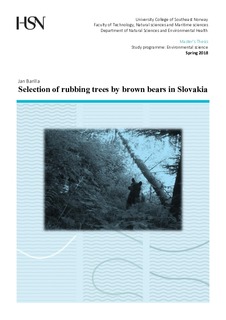Selection of rubbing trees by brown bears in Slovakia
Master thesis
Published version
Permanent lenke
http://hdl.handle.net/11250/2584791Utgivelsesdato
2018Metadata
Vis full innførselSamlinger
Sammendrag
Chemical communication in bears is not fully understood, despite the importance of this topic for the behavioral ecology as well as for the conservation and management of Ursids. Brown bears often mark trees by rubbing on them as well as biting and clawing of the bark. Such rubbing trees are often used for the collection of hair samples for genetic analyses needed for management purposes. The aim of this study was to document rubbing trees in the eastern part of Tatra National Park, Slovakia, and to create a predictive habitat model to guide searches for rub trees in other parts of Slovakia. We created a grid system of 100 random transects in a 140km2 study area, and walked the trails and random transects in search for rub trees from March to October 2015-2017. For each rub tree we recorded its location in the landscape, the habitat type surrounding it, as well as several variables describing the tree itself. We documented 85 rub trees in the protected area Belianske Tatry. These trees were significantly more often located along trails in comparison to random transects, however, bears also seemed to prefer less human-frequented (i.e., seasonally closed) trails. Bears significantly preferred coniferous tree species: Norway spruce and European larch with a trunk diameter larger than the mean trunk diameter of trees in its vicinity. We created a predictive model for rubbing trees using Maximum Entropy modelling (MaxEnt), based on only-presence data of rub trees and 9 environmental variables. The final model are 100 replicates of MaxEnt algorithm with random seed of training samples resulted in an average training Area under curve (AUC) value of AUC value of 0.941 ± 0.012. This model could help to simplify design of genetic studies for monitoring of population and studies about rubbing behavior of brown bears in the Tatra National Park and other areas in Slovakia. But it will also provide insight in the chemical communication of bears.
